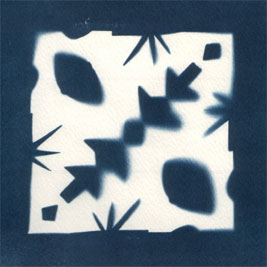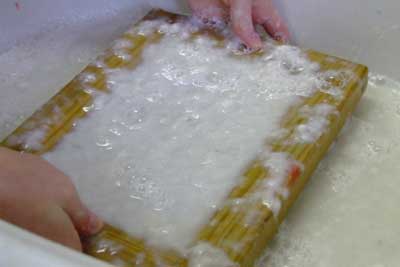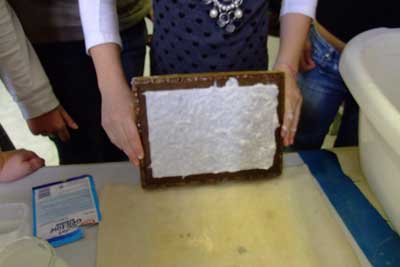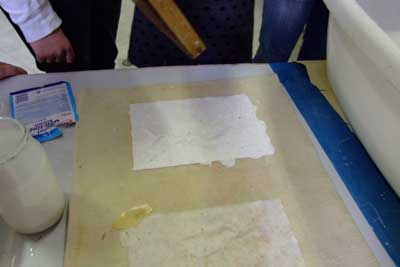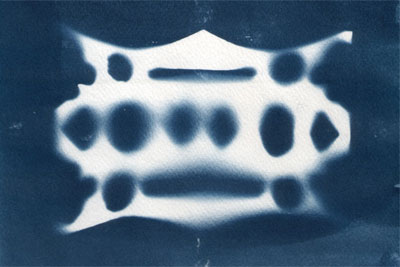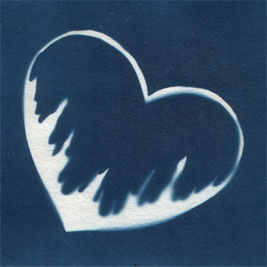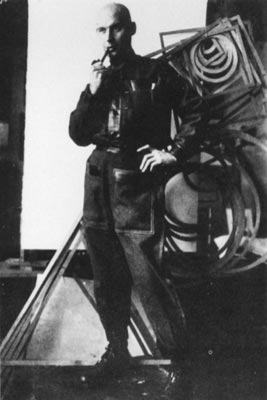home > artwork > snow globe / schneekugel
overview : statement : blog : self-interview : press : catalog
|
Snow Globe / Schneekugel A self interview... Q. Why are the pictures inverted, upside-down and backwards, and blue? A. Chemistry, Physics and the principles of Optics dictate that the image is inverted, upside-down and backwards. As we all know, with modern photographic techniques this can all be corrected. But, I am not a photographer and I am not interested in taking photographs. What I am interested in is capturing traces of residue of the work, like scientific evidence of the existence of the art. The blue is a result of the Cyanotype photographic process, which I chose because of its simplicity and accessibility. The students in chemistry class actually mix the chemicals to make the photo paper, and the photographs are simply developed in water. The students see a real world application of chemistry, a connection or synthesis between chemistry and art. Q. Why handmade paper? Is this also a way to involve the students? A. Yes, in the same way that the cyanotype process is accessible, so is paper making. But maybe more importantly for me is the precious quality of handmade paper (that is not present in machine made paper). Making it myself also allows me to incorporate pages from textbooks into the paper. This adds a personal connection to each school and another layer to the metaphor of internalization. The codified knowledge of the society is literally being internalized into the artistic object. The project as a whole functions generally as a metaphor for the way we internalize the world, and specifically for the way school children internalize cultural knowledge and the knowledge of the society. Q. You mentioned preciousness. Why is that important? A. The preciousness of the handmade paper is important to me because for a very long time I have been fascinated by the phenomenon of the projected image and the preciousness of the miniaturized world. It is as if you can hold the world in your hands, like a little snow globe, hence the title of the work. In fact, this project developed out of my fascination with this phenomenon and later took on the added layers of meaning. Q. What are these added layers of meaning? A. It is a metaphor for the process of internalization and the constructed nature of reality. We see this piece of reality and that piece of reality and we take it all in and try to connect it all together as best we can. Through this process we start to understand the world around us, and our relation to it. Q. Why did you then later choose to connect this phenomenon with schools? A. I want to challenge the students to think critically about this process of internalization. What are they being "asked" to internalize and why? I want the students to see that things that they may see as inherent to their being are really internalizations of society. Obviously not all of the students will understand these readings of the work. The depth and nature of the discussion depends on the age of the group that particular day, but I have been quite successful at explaining the metaphor, even with 7 year olds. Also, the artwork is operating not only on an intellectual level but also on an interactive level. One of the things that capitalistic society tells us to internalize is that we are consumers. I am challenging this by directly involving the students in the production of the art through papermaking, preparing the chemicals, and so on. Q. Everything in your work seems to have a reason or meaning behind it. Why have you chosen these specific schools from all the schools in Jena? A. Well, as I mentioned earlier I am asking the students to think critically about what they are being asked to internalize. By choosing these three schools, a Gymnasium, a Gesamtschule, and a Regelschule, I am also asking them to consider how what they learn and internalize is different from students in other schools. In particular how does the socioeconomic hierarchy embedded in the structure of the educational system itself affect the identities of the students? Q. There seams to be a theme of internalization running through some of your past work, for example, your BFA thesis exhibition. Would you agree? And if so, could you elaborate on why you are drawn to this theme? A. Boy, that's a tough one. Yes, I do agree that there is this theme of internalization, but I don't think I fully understand it yet. Part of it I think has to do with a feeling I have from time to time, a sort of "awakening" feeling and almost like a calling to share this with others. What I mean is a certain clarity, an awareness of the connectedness of everything and the profound rationality of the universe. Q. What you describe sounds spiritual, almost religious. A. Yes, I have thought the same thing many times. It is strange because my parents were not religious and I was not raised as a part of any organized religion. I never attended church as a child. My father was once in the seminary, but renounced Catholicism before I was born. My mother was very much into new age energy work and my grandfather was a Priest in the UCC [United Church of Christ]. So there was definitely exposure or influence there, but not usually directly. In my 20's I began to more consciously open myself up to different psychological and spiritual ideas, but always with a sense of the underlying sameness and oneness. This sounds very eastern or Buddhist, but for me this sense of oneness comes from my intense study of physics as a freshman in college. I was accepted into college as a physics major and I was simultaneously taking honors physics and honors calculus when I had the profound realization of the implications of Einstein's infamous E = mc2. The realization was something akin to what is explored in a light hearted manner in the movie "I Heart Huckabees" when Mark Wahlberg and Dustin Hoffman get into an argument about the particles that make up the universe and the nothingness in between. Hoffman finally ends it by saying, "If you look close enough you can't tell where my nose ends and space begins." I don't know if this answers your question about the theme of internalization. Q. Yes, in a way I think it does. I would say that the internalization that your work explores is, at least in this project, the internalization of roles and structures that lead us to identify ourselves as separate and individual. And what you are asking people to do is to think critically about this. A. Yes, this "awakening" that I described is often a sense that our reality is constructed in our minds and that any separateness or boundaries we perceive are not inherent objective parts of "capital R" Reality, but subjective parts of our internalized reality. For me this is a really positive and hopeful thing because it offers us the opportunity to affect change in the world. But this change must start with ourselves, with individuals and when enough people have changed their realities, then the collective reality of society and civilization will change. I think societal and civilization change was the socialist dream and vision of communism. In fact, there is a way in which I relate Snow Globe to Russian Revolutionary art. Q. Really! A. Maybe I shouldn't open up that can of worms, since I'm not a historian or theoretician. Q. Yeah, lets just leave it at a metaphor for internalized realities... although, there is a certain Constructivist attitude to your notion that your vision of Reality offers us the opportunity to affect change by constructing "realities in our minds." A. Yeah, or you could say Productionist because I am actually going into the "Cultural Factories," the schools where culture is reproduced and collaborating with the teachers. And the Constructivist declaration of the end of art[1] comes to mind, because in a way my work could be seen as simply a utilitarian didactic tool for learning philosophy, chemistry, papermaking, physics and optics. Q. Which brings us full circle to your answer to my first question. |
|
Notes: "Cultural Factories" is my own phrase. I use it because I heard this idea somewhere a long time ago that Culture is the number 1 export of the United States. I don't know where I heard it or how one would quantitatively measure cultural export, but the important thing is that it stuck with me and influenced my thinking. It led me to ask myself, if you can export Culture, where is it produced? I came up with several ideas of where it could be produced including schools. Of course schools are not the only place where people are indoctrinated into a culture, but the schools are the "Cultural Factories" that I chose for this project. Relating my work to the Productionists is based on my limited understanding or misunderstanding of the ideas of the Productionists. What I am referring to here is my understanding of some text that I read and which inspired me while working on this project.[2],[3],[4],[5],[6] At the time I was taking a Fachcurse on Russian revolutionary art. I was assigned to do a presentation on Alexander Rodchenko, which led me to read about Constructivism and eventually to the writings and theories of Boris Arvatov. It is my understanding that the Productionist strategy/theory was for artists to go into the factories where products are produced and work to activate them as comrades in shaping society. "Our things in our hands must be equals, comrades."[7] My understanding is that the key concept of the article Rodchenko in Paris is the idea of the Constructivist object (or the Constructivist theory of the object). The idea is that the Constructivist object would be a comrade, or an organ of human activity. There would be this transparent relay between the consciousness of the maker and the consciousness of the object. In contrast, the Western commodity works to organize desire and construct identities, but as I see it working in a subconscious way, not transparently. The Constructivist would work with the object to consciously construct identity, society and the future. They would do this without severing the social relationship between the producer and consumer of the object, as the Western commodity does by replacing use value with exchange value and placing the "market" in the middle. Commodity fetishism obscures the social relationship between exploiter and exploited and neither side is fully conscious of the political positions they occupy.[8] There is also this idea that the Constructivist object is alive. The object changes as its use changes. Back to the organ of human activity, the constructivist object is not separated from its use. There is a focus on use-value instead of exchange-value. Exchange-value is associated with the commodity (the capitalist object). Kiaer notes Rodchenko's disgust with "the most destructive incarnation of the commodified relation between subject and object that he sees in Paris: the cult of woman as thing."[9] So, with this understanding of Productivism and Constructivism I began to think of what I was doing as similar to Russian revolutionary art. The children are the products of the "Cultural Factories" and I am helping to shape them as active comrades in shaping society. 1 Harrison, Charles and Paul Wood editors, Art in Theory 1900-2000, An Anthology of Changing Ideas, 2nd Ed., Blackwell Publishing, (2003) USA, pp. 340 2Kiaer, Christina, Rodchenko in Paris, October, Vol. 75. (Winter, 1996), pp. 3-35 3Kiaer, Christina, Boris Arvatov's Socialist Objects, October, Vol. 81. (Summer, 1997), pp. 105-118 4Arvatov, Boris; Translated by Christina Kiaer, Everyday Life and the Culture of the Thing (Toward the Formation of the Question), October, Vol. 81. (Summer, 1997), pp. 119-128 5Levinger, Esther, Art and Mathematics in the Thought of El Lissitzky: His Relationship to Suprematism and Constructivism, Leonardo, Vol. 22, No. 2 (1989), pp. 227-236 6Harrison, 2003 7Kiaer, Rodchenko in Paris, 1996, pp. 4 8http://en.wikipedia.org/wiki/Commodity_fetishism viewed on Jan 22, 2008 9Kiaer, Rodchenko in Paris, 1996, pp. 14 10Kiaer, Rodchenko in Paris, 1996, pp. 11 |

